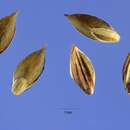Description
provided by eFloras
Annual. culms decumbent, rooting at lower nodes, 30–60 cm tall. Leaf sheaths glabrous or lower sheaths papillose-pilose; leaf blades linear, 2.5–15 × 0.2–0.9 mm, usually scabrid on both surfaces, rarely sparsely pilose; ligule 1–3.5 mm. Inflorescence digitate or subdigitate; racemes 2–5, 4–14 cm; spikelets paired, imbricate; rachis triquetrous, ca. 1 mm wide, winged. Spikelets lanceolate, ca. 3 mm, those of a pair usually different; lower spikelet glabrous, upper spikelet pubescent; lower glume very small, almost absent or up to 0.4 mm, triangular or bifid, veinless; upper glume lanceolate, ca. 2/3 length of spikelet, 3-veined, pilose; lower lemma as long as spikelet, 7-veined, lower spikelet with equidistant veins, upper spikelet with wider glabrous interspaces on either side of midvein, lateral veins crowded near margins, rows of silky hairs between lateral veins, usually also setose, the hairs spreading halo-like at maturity; upper lemma yellowish, slightly shorter than spikelet. Fl. and fr. May–Sep. 2n = 54, 72.
- license
- cc-by-nc-sa-3.0
- copyright
- Missouri Botanical Garden, 4344 Shaw Boulevard, St. Louis, MO, 63110 USA
Distribution
provided by eFloras
Fujian, Hainan, Yunnan [India, Indonesia, Malaysia, Myanmar, New Guinea, Sri Lanka, Thailand; Africa, Australia; introduced in America].
- license
- cc-by-nc-sa-3.0
- copyright
- Missouri Botanical Garden, 4344 Shaw Boulevard, St. Louis, MO, 63110 USA
Habitat
provided by eFloras
Waste ground, often on sand, including seashore sand; below 2000 m.
- license
- cc-by-nc-sa-3.0
- copyright
- Missouri Botanical Garden, 4344 Shaw Boulevard, St. Louis, MO, 63110 USA
Synonym
provided by eFloras
Paspalum bicorne Lamarck, Tabl. Encycl. 1: 176. 1791; Digitaria biformis Willdenow; Panicum bicorne (Lamarck) Kunth; P. biforme (Willdenow) Kunth.
- license
- cc-by-nc-sa-3.0
- copyright
- Missouri Botanical Garden, 4344 Shaw Boulevard, St. Louis, MO, 63110 USA
Physical Description
provided by USDA PLANTS text
Annuals, Terrestrial, not aquatic, Stolons or runners present, Stems nodes swollen or brittle, Stems geniculate, decumbent, or lax, sometimes rooting at nodes, Stems mat or turf forming, Stems terete, round in cross section, or polygonal, Stem internodes hollow, Stems with inflorescence less than 1 m tall, Stems, culms, or scapes exceeding basal leaves, Leaves mostly cauline, Leaves conspicuously 2-ranked, distichous, Leaves sheathing at base, Leaf sheath mostly open, or loose, Leaf sheath hairy, hispid or prickly, Leaf sheath and blade differentiated, Leaf blades linear, Leaf blades 2-10 mm wide, Leaf blades mostly flat, Leaf blades mostly glabrous, Leaf blades more or less hairy, Ligule present, Ligule an unfringed eciliate membrane, Inflorescence terminal, Inflorescence solitary, with 1 spike, fascicle, glomerule, head, or cluster per stem or culm, Inflorescence a panicle with digitately arranged spicate branches, Inflorescence with 2-10 branches, Inflorescence branches 1-sided, Lower panicle branches whorled, Rachis winged, Rachis angular, Flowers bisexual, Spikelets pedicellate, Spikelets dorsally compressed or terete, Spikelet less than 3 mm wide, Spikelets with 1 fertile floret, Spikelets with 2 florets, Spikelet with 1 fertile floret and 1-2 sterile florets, Spikelets paired at rachis nodes, Spikelets all alike and fertille, Spikelets bisexual, Spikelets disarticulating below the glumes, Spikelets secund, in rows on one side of rachis, Rachilla or pedicel glabrous, Glumes present, empty bracts, Glumes 1 clearly present, the other greatly reduced or absent, Glumes 2 clearly present, Glumes distinctly unequal, Glumes equal to or longer than adjacent lemma, Glume equal to or longer than spikelet, Glume surface hairy, villous or pilose, Glumes 3 nerved, Lemmas thin, chartaceous, hyaline, cartilaginous, or membranous, Lemma similar in texture to glumes, Lemma 5-7 nerved, Lemma apex acute or acuminate, Lemma awnless, Lemma margins thin, lying flat, Lemma straight, Palea present, well developed, Palea membranous, hyaline, Palea about equal to lemma, Stamens 3, Styles 2-fid, deeply 2-branched, Stigmas 2, Fruit - caryopsis, Caryopsis ellipsoid, longitudinally grooved, hilum long-linear.

